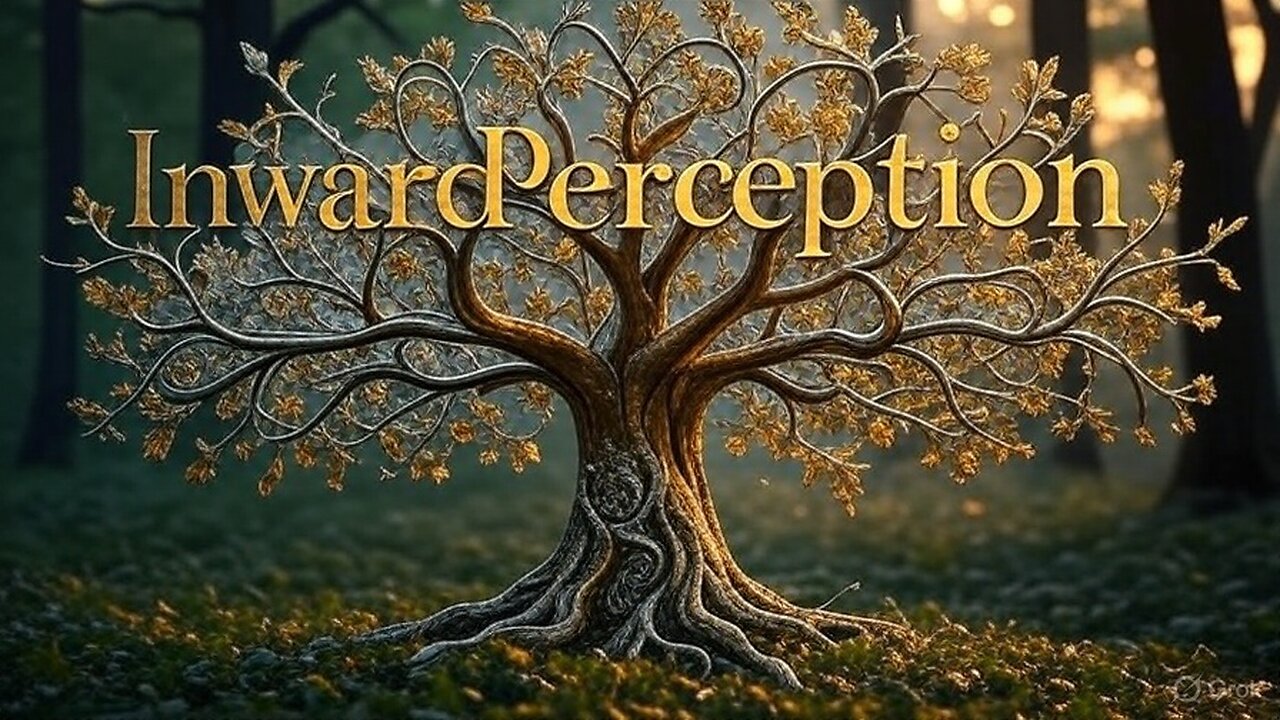Premium Only Content

The Inner Cosmos: Manly P. Hall's Journey into the Depths of Perception
paypal https://paypal.me/MysterySchool33
The Inner Cosmos: Manly P. Hall's Journey into the Depths of PerceptionManly Palmer Hall, the enigmatic philosopher, mystic, and prolific author whose life spanned the turbulent bridge from the Edwardian era to the dawn of the digital age, stands as one of the 20th century's most profound interpreters of the arcane. Born in 1901 in Peterborough, Ontario, Hall's early immersion in theosophy, Freemasonry, and Rosicrucianism propelled him into a lifelong quest to unveil the veiled truths of existence. His magnum opus, The Secret Teachings of All Ages (1928), remains a cornerstone of esoteric literature, but it is in lesser-known works like The Inner Cosmos: Manly P. Hall's Journey into the Depths of Perception—published posthumously in a curated edition in 1992—that we witness the full flowering of his introspective genius. This 512-page tome, compiled from Hall's unpublished lectures, journals, and meditative writings from the 1940s through the 1960s, is not merely a book; it is a cartography of the soul, a luminous map guiding the seeker through the labyrinthine realms of inner perception. At its core, The Inner Cosmos posits that the universe without is but a reflection of the universe within, and true enlightenment arises not from external conquest but from the disciplined exploration of perceptual depths.Hall's journey in this work is both personal and universal, a narrative woven from threads of ancient wisdom traditions—Hermeticism, Kabbalah, Vedanta, and Platonic idealism—interlaced with modern insights from psychology and quantum theory. He describes perception not as a passive reception of sensory data but as an active alchemy, wherein the observer transmutes raw phenomena into symbols of divine intelligence. "The eye sees only what the mind is prepared to comprehend," Hall writes in the preface, a sentiment echoed throughout the text like a recurring mantra. This book, then, is an invitation to embark on a heroic odyssey: to descend into the psyche's subterranean chambers, confront the shadows of illusion, and ascend into the radiant spheres of cosmic unity.The structure of The Inner Cosmos mirrors the Hermetic principle of "as above, so below," divided into three principal sections: The Threshold of Awareness, The Labyrinth of Symbols, and The Apex of Illumination. Each section builds upon the last, progressing from foundational exercises in mindfulness to profound metaphysical revelations. Hall's prose is characteristically erudite yet accessible, blending scholarly exegesis with poetic flourishes. He draws liberally from primary sources—quoting Plotinus on the emanation of the One, Meister Eckhart on the birth of God in the soul, and Lao Tzu on the Tao's ineffable flow—while grounding these abstractions in practical meditations and visualizations. Readers are not mere spectators; they are apprentices in Hall's invisible academy, tasked with applying the principles to their own perceptual faculties.The Threshold of Awareness: Awakening the Inner SensesThe opening section, comprising the first 150 pages, serves as the initiatory portal, demystifying the mechanics of perception. Hall begins with a critique of materialist science, which he views as a "myopic lens" that fragments reality into isolated particles, blind to the holistic web of consciousness. Drawing from his studies in Eastern philosophy, he introduces the concept of prajna, or intuitive wisdom, as the antidote to fragmented seeing. "In the outer cosmos, stars whirl in gravitational dances unseen by the naked eye," he observes; "so too does the inner cosmos pulse with rhythms imperceptible to the untrained soul."Here, Hall delineates the "seven veils of perception," a schema inspired by the Sufi poet Rumi and the Kabbalistic Tree of Life. The first veil is sensory illusion, where the five physical senses—sight, sound, touch, taste, and smell—dominate, chaining the mind to ephemeral forms. Hall illustrates this with a vivid analogy: imagine a prisoner in Plato's cave, mistaking shadows for substance. To pierce this veil, he prescribes daily exercises in sensory detachment, such as the "Breath of Stillness," a pranayama technique borrowed from yogic traditions. Practitioners inhale deeply, visualizing breath as golden light flooding the body's nadis (energy channels), then exhale doubts and distractions. Over weeks of practice, one cultivates viveka, discernment, allowing subtler perceptions to emerge.The second veil concerns emotional turbulence, where unchecked passions distort reality like a funhouse mirror. Hall recounts a personal anecdote from his 1930s travels in India, where he witnessed a fakir levitate not through physical defiance of gravity but by transcending emotional gravity—the weight of fear and desire. This leads into a discourse on the chakras as perceptual filters: the root chakra (Muladhara) grounds us in survival instincts, while the crown (Sahasrara) opens to unitive vision. Hall warns against premature ascension, advocating a gradual "ladder of the self," rung by rung, to avoid the pitfalls of spiritual bypass.By the section's midpoint, Hall shifts to the cognitive veils, exploring how language and belief systems shape perception. He critiques Western dualism—mind versus matter, self versus other—as a linguistic prison, contrasting it with the non-dual advaita of Shankara. A pivotal chapter, "The Mirror of Maya," dissects illusion (maya) as the cosmic sleight-of-hand that veils unity. Hall employs alchemical symbolism here, likening perception to the nigredo stage: dissolution of egoic constructs to reveal prima materia, the raw stuff of consciousness. Exercises include journaling "perceptual paradoxes," such as contemplating the wave-particle duality in quantum mechanics as a metaphor for the self's illusory boundaries.This foundational arc culminates in "The Awakening Gaze," a meditation on drishti (focused vision) from Tantric yoga. Hall guides readers through visualizations of the third eye, urging them to "gaze inward until the gazer dissolves into the gazed-upon." At 150 pages, this section equips the novice with tools to stand at the threshold, poised for deeper descent. Hall's tone is encouraging yet stern: "Awareness is not a gift bestowed; it is a fire kindled by friction of will against illusion."The Labyrinth of Symbols: Navigating the Psyche's DepthsTransitioning into the heart of the book, The Labyrinth of Symbols spans 200 pages of dense, symbolic exegesis, where Hall transforms the inner cosmos into a mythic landscape. Here, perception evolves from mere awareness to interpretive artistry, with symbols as the hieroglyphs of the soul. Influenced by his Masonic affiliations, Hall views symbols not as arbitrary signs but as living archetypes, bridges between the personal unconscious and the collective oversoul.The labyrinth motif draws from the Cretan myth of Theseus and the Minotaur, symbolizing the ego's confrontation with its shadow. Hall maps this onto Jungian psychology, which he encountered through mutual friends in the esoteric circles of Los Angeles. "The Minotaur is not a beast to slay," he writes, "but a fragment of divinity distorted by neglect. Slay it, and you orphan your wholeness." Chapters unfold as initiatory trials: "The Thread of Ariadne" explores memory as a golden filament guiding through forgetfulness; "The Echoes of Orpheus" delves into auditory symbols, where inner sounds—mantras, overtones of silence—resonate with cosmic harmonies.A standout sequence is the "Mandala of the Four Elements," a 50-page meditation on perceptual equilibrium. Hall assigns each element a perceptual mode: Earth for tactile solidity, Water for fluid intuition, Air for intellectual abstraction, and Fire for visionary ignition. Imbalances yield distorted perception—excess Earth breeds materialism, excess Fire fanaticism. To harmonize, he offers the "Elemental Invocation," a ritual invoking each quarter of the self with corresponding gems (e.g., quartz for Earth) and incantations from the Emerald Tablet. This practice, Hall claims, attunes the aura to subtle energies, allowing one to "perceive the etheric body as a luminous garment woven from starlight."Hall's eclecticism shines in cross-cultural symbology. He parallels the Egyptian ka (vital double) with the Platonic daimon (inner genius), both as perceptual guides through dream realms. Dreams, for Hall, are the antechamber to the akashic records, that ethereal library of all souls' impressions. A chapter on "Nocturnal Cartography" instructs in lucid dreaming: before sleep, inscribe intentions on paper, then visualize descending a spiral stair into the subconscious sea. Upon awakening, decode symbols via free association, revealing perceptual blind spots.Yet, the labyrinth harbors perils: the siren call of glamour, where psychic phenomena dazzle without wisdom. Hall recounts encounters with mediums in his youth, discerning genuine clairvoyance from egoic projection. "True perception pierces the veil without tearing it," he cautions. This section's philosophical climax is "The Rose Cross of Perception," a Rosicrucian emblem integrating the senses into a cruciform unity. The horizontal bar represents empirical knowing; the vertical, transcendent insight; their intersection, gnosis. Hall illustrates with diagrams—reproduced from his journals—showing how meditative focus on the heart chakra blooms this rose, unveiling synchronicities as perceptual confirmations.Throughout, Hall's voice remains that of the elder sage, weaving humor into profundity: "Many seek the Holy Grail in distant lands, forgetting it is the cup from which they drink their morning tea." By section's end, the reader emerges from the labyrinth not unscathed, but enriched—symbols no longer enigmas, but allies in the perceptual forge.The Apex of Illumination: Union with the InfiniteThe final section, The Apex of Illumination, ascends to rarified heights, comprising 150 pages of transcendent speculation. Here, perception transcends individuality, merging with the nous—the divine intellect of Plotinus. Hall envisions the inner cosmos as a microcosm of the macrocosm, where enlightened perception reveals the universe as a symphony of interdependent vibrations.Opening with "The Noetic Flame," Hall describes illumination as a sudden ignition, akin to the alchemical rubedo. Drawing from his correspondence with Carl Jung, he explores archetypes as perceptual archetypes: the Hero's Journey as eternal template for inner quests. "Every soul is Odysseus, adrift on seas of illusion, homing to Ithaca—the Self," he poetizes. Practical paths include the "Solar Invocation," aligning personal will with cosmic purpose via dawn meditations on the sun as perceptual archetype.A profound chapter, "The Quantum Veil," bridges esotericism and science. Hall, presciently, anticipates entanglement theory: "Particles whisper across voids, as thoughts echo in the noosphere." Perception, he argues, collapses wave functions of possibility into chosen realities. Exercises involve "entangled gazing," pairing with a partner to synchronize breaths and visions, fostering telepathic rapport.Hall then ascends to mystical union, invoking the unio mystica of St. John of the Cross. "In the depths of perception lies the ground of being," he declares, echoing Meister Eckhart. The "Dark Night of the Senses" is reframed not as suffering but as purification, stripping perceptual dross to reveal the pneuma—holy spirit within. Visions here are cautioned: they are veils upon veils, ladders to discard upon summit.The book's apotheosis is "The Mandorla of Eternity," a visionary synthesis. The mandorla—almond-shaped overlap of circles—symbolizes the intersection of finite and infinite perception. Hall guides a final meditation: envision two spheres, one earthly, one celestial, merging in the heart. Within this vesica piscis blooms the inner cosmos: galaxies of thought, nebulae of emotion, black holes of unresolved karma. "Here, the perceiver and perceived annul in bliss," he concludes.Themes and Legacy: Echoes in the Eternal NowThematically, The Inner Cosmos reverberates with Hall's perennial philosophy: all paths lead to one truth, veiled in cultural garb. Key motifs include the sanctity of silence ("The tongue of the wise is in the heart"), the ethics of perception (to see truly is to act compassionately), and the evolutionary arc of consciousness—from primal instinct to cosmic co-creation.Hall's influence permeates modern spirituality: echoes in Eckhart Tolle's presence teachings, Deepak Chopra's mind-body synthesis, and even neuroscientific explorations of mindfulness. Yet, The Inner Cosmos remains underappreciated, perhaps too vast for soundbite culture. Critics praise its depth but note its density; enthusiasts hail it as a "perceptual bible."In sum, this work encapsulates Hall's journey: from curious youth to enlightened elder, ever probing perception's depths. To read it is to journey oneself—into the inner cosmos, where stars are born of silence, and perception dawns as divine play. As Hall might say, "The universe awaits not your arrival, but your awakening."
-
 2:35:10
2:35:10
Alan Watts Remastered
25 days agoAlan Watts, Life Is Suffering
233 -
 2:03:41
2:03:41
TimcastIRL
3 hours agoTrump To Deploy National Guard To Chicago, Federal TAKEOVER Begins | Timcast IRL
164K96 -
 LIVE
LIVE
PandaSub2000
8 hours agoLIVE 10pm ET | SILENT HILL F w/TinyPandaFace
183 watching -
 1:26:00
1:26:00
Glenn Greenwald
8 hours agoNick Fuentes On Censorship, Charlie Kirk's Assassination, Trump's Foreign Policy, Israel/Gaza, the Future of the GOP, and More | SYSTEM UPDATE #523
90.5K261 -
 LIVE
LIVE
StevieTLIVE
4 hours ago#1 Kar98 Warzone POV Monday MOTIVATION
71 watching -
 LIVE
LIVE
a12cat34dog
4 hours agoTHE *NEW* SILENT HILL :: SILENT HILL f :: IS IT GOOD!? {18+}
125 watching -
 1:00:21
1:00:21
Akademiks
2 hours agonba youngboy live show.
23.5K1 -
 LIVE
LIVE
The Quartering
2 hours agoThey Just Stopped Another Attack, Trump Defeats Youtube, Hasan PIker Meltdown & More
1,888 watching -

megimu32
2 hours agoOn The Subject: Football Movies of the 90s & 2000s
1.18K3 -
 LIVE
LIVE
Technically Mexican
2 hours agoI Play Hollow Knight: SILKSONG! #18
14 watching